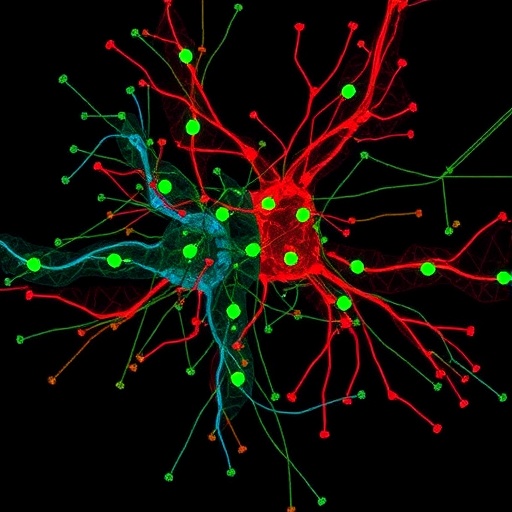In the complex landscape of ovarian biology, understanding the cellular composition of the ovarian cortex has remained a significant challenge for researchers. Recent advancements in multicolor flow cytometry have opened new avenues for dissecting intricate cellular heterogeneities, particularly in identifying subpopulations of ovarian cortex cells. The groundbreaking study by Frontczak et al. aims to unravel these complexities, paving the way for enhanced insights into ovarian health and disease.
The ovarian cortex, housing numerous follicles and pre-granulosa cells, is critical for reproductive function. However, the diverse cellular makeup and their respective roles in ovarian physiology have not been fully characterized. This study employs a cutting-edge technique known as multicolor flow cytometry, which allows for the simultaneous analysis of multiple cellular markers. Such precision is crucial in distinguishing between closely related cell types, which could have significant implications for understanding follicle development and oocyte maturation.
Multicolor flow cytometry involves tagging cells with a series of fluorescent antibodies that bind to specific surface markers. This method enables researchers to quantify and sort cells based on their fluorescence intensity, thus revealing complexities obscured in traditional methods. By applying this technology to ovarian cortex samples, Frontczak et al. can isolate distinct cell populations, each potentially contributing differently to ovarian function and pathology.
An essential aspect of this study is the rigorous antibody panel developed by the researchers. The panel is meticulously designed to target specific markers relevant to ovarian cells, ensuring that the data collected is both reliable and comprehensive. This strategic approach minimizes the potential for cross-reactivity, thus enhancing the accuracy of cell identification. Such a meticulously designed workflow highlights the evolution of flow cytometry as a vital tool in reproductive biology.
The research team conducted multiple experiments on ovarian cortex samples obtained from various biological models. By integrating these findings, they succeeded in categorizing novel subpopulations of cells—each displaying unique markers and potentially varying functional roles. This categorization is not merely an academic exercise but serves as the foundation for understanding how these diverse cell types interact during ovarian function and how their dysregulation could lead to pathological states, including infertility or ovarian cancer.
In particular, identifying the distinct roles of immune and stromal cells within the ovarian cortex was a pivotal focus of this research. These cells are often underrepresented in studies focusing solely on germ cells. However, emerging evidence suggests they play crucial roles in follicle development, hormonal regulation, and responding to environmental stressors. The novel findings from this study may lead to a paradigm shift in how we perceive the multifaceted roles of these non-germinal cells within the ovary.
Moreover, the implications of this research extend beyond ovarian health. It promises to impact reproductive technologies and fertility treatments. By elucidating the cellular landscape of the ovarian cortex, researchers can better design and tailor interventions that may improve outcomes for individuals facing infertility. Understanding how specific cell types contribute to ovarian reserve and function could lead to the development of personalized medical approaches for fertility preservation.
Another significant aspect of this study is its potential linkage to translational research. By establishing a clearer understanding of ovarian cell populations, medical researchers may better grasp how these cells behave in pathological conditions such as polycystic ovary syndrome (PCOS) or ovarian neoplasms. The insights gained from such studies could eventually translate into novel therapeutic strategies that target these unique subpopulations, aiming to restore normal ovarian function or mitigate disease progression.
Critically, the application of multicolor flow cytometry not only provides cellular characterization but also offers insights into the functional states of cells. Researchers can gauge activation states, developmental stages, and even metabolic profiles, leading to a more holistic view of ovarian biology. This might help unpack the myriad of interactions that occur within the ovarian microenvironment, further informing how cellular signals orchestrate ovarian dynamics.
The rigorous methodology adopted by Frontczak et al. also underscores the importance of reproducibility in scientific discovery. Each step, from sample preparation to data analysis, was carefully validated, ensuring that their findings could serve as a benchmark for future studies. In an era where scientific transparency is paramount, such meticulous documentation emphasizes the responsibility researchers have towards reproducing credible and actionable scientific knowledge.
Peer feedback from the broader scientific community has also been overwhelmingly positive, with experts applauding the study’s innovative approach to a well-established field. The ability to dissect ovarian cell populations using multicolor flow cytometry is expected to inspire new research trajectories, prompting a deeper exploration of ovarian biology and its intersection with systemic physiology.
As the scientific dialogue continues around the implications of this research, attention will undoubtedly pivot towards the next steps. Future studies will need to explore the functional relevance of these identified cell subpopulations. Investigating how they interact with hormones and systemic signals will be crucial in forming an integrated understanding of ovarian function and its dependencies.
In conclusion, the study by Frontczak et al. presents an exciting frontier in ovarian research, positioning multicolor flow cytometry as a transformative tool for understanding the cellular nuances within the ovarian cortex. As this field evolves, it holds promise not only for advancing our knowledge of ovarian biology but also for translating these findings into meaningful clinical applications. This research exemplifies how modern techniques can unravel intricate biological questions, ultimately contributing to enhanced reproductive health for individuals worldwide.
As scientists continue to explore the complex cellular dynamics at play in the ovarian cortex, it is clear that innovations like multicolor flow cytometry will be foundational. They not only serve as critical tools for discovery but also inspire future research to address pressing questions in reproductive health. The world watches with anticipation as insights from this study begin to impact our understanding of ovarian biology, fertility, and disease management.
Subject of Research: Identification and characterization of ovarian cortex cell subpopulations using multicolor flow cytometry.
Article Title: Identifying ovarian cortex cell subpopulations using multicolor flow cytometry.
Article References:
Frontczak, S., Zver, T., Pretalli, JB. et al. Identifying ovarian cortex cell subpopulations using multicolor flow cytometry.
J Ovarian Res 18, 215 (2025). https://doi.org/10.1186/s13048-025-01775-3
Image Credits: AI Generated
DOI: 10.1186/s13048-025-01775-3
Keywords: multicolor flow cytometry, ovarian cortex, cell subpopulations, reproductive health, ovarian biology.
Tags: advanced techniques in reproductive biologyanalysis of ovarian health and diseasecellular heterogeneity in ovariescellular markers in ovarian biologycutting-edge research in ovarian physiologydissecting ovarian cellular compositionfluorescent antibody tagging in cell analysisidentifying ovarian follicle cell typesimplications for oocyte maturation studiesmulticolor flow cytometry in ovarian researchovarian cortex cell subpopulationsunderstanding pre-granulosa cell roles





